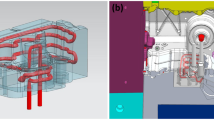Abstract
Copper cladding aluminum (CCA) rods with a diameter of 30 mm and a sheath thickness of 3 mm were fabricated by horizontal core-filling continuous casting (HCFC) technology. The effects of key processing parameters, such as the length of the mandrel tube of composite mold, aluminum casting temperature, flux of the secondary cooling water, and mean withdrawing speed were optimized based on some quality criteria, including the uniformity of the sheath thickness, integrality of the rods, and thickness of the interface. The causes of internal flaws formation of CCA rods were also discussed. The results showed that the continuity of the liquid aluminum core-filling process and the interface reaction control between solid copper and liquid aluminum were two key problems that strongly affected the stability of the casting process and the product quality. Our research indicated that for the CCA rod with the previously mentioned size, the optimal length of mandrel tube was 210 mm. A shorter mandrel tube allowed of easier erosion at the interface, which led to a nonuniform sheath thickness. Conversely, it tended to result in a discontinuous filling process of liquid aluminum, which causes shrinkage or cold shuts. The optimal casting temperatures of copper and aluminum were 1503 K (1230 °C) and 1043 K to 1123 K (770 °C to 850 °C), respectively. When the casting temperature of aluminum was below 1043 K (770 °C), the casting process would be discontinuous, resulting in shrinkages or cold shuts. Nevertheless, when the casting temperature of aluminum was higher than 1123 K (850 °C), a severe interface reaction between solid copper and liquid aluminum would occur. The proper flux of the secondary cooling water and the mean withdrawing speed were determined as 600 to 800 L/h and 60 to 87 mm/min, respectively. In the previously mentioned proper ranges of processing parameters, the interfacial shear strengths of CCA rods were 40.5 to 67.9 MPa.






Similar content being viewed by others
References
W. Perrard: Wire J. Int., 2001, vol. 34, pp. 154-59.
K.Y. Rhee, W.Y. Han, H.J. Park, and S.S. Kim: Mater. Sci. Eng. A, 2004, vol. 384, pp. 70-76.
A. Gibson: Wire J. Int., 2007, vol. 40, pp. 73.
A Gibson: Wire J. Int., 2008, vol. 41, pp. 142-48.
X.F. Liu, X.H. Liu, Q.N. Wang, and J.X. Xie: Advanced Technology of Plasticity 2008, Eds. D.Y. Yang, Y.H. Kim, and C.H. Park, Korean Society for Technology of Plasticity, Gyeongju, Korea, 2008, pp. 454–59.
N. Kazuyuki: ISIJ Int., 1997, vol. 7, pp. 899-905.
M. Hiderita, T. Yamaguchi, and T. Takayama: US Patent US03854193A, 1974.
Y.K. Dai, X.S. Yang, and Q.T. Zhu: China Patent ZL96238273.6, 1998.
Y. Z. WU, Y.Q. Ma, S.Y. Liu, and Y. Zhang: Welding Joining, 2006, vol. 4, pp. 40-42.
C.E. Webber and G.W. Drescher: US Patent 3421571, 1969.
N.F. Neumann: US Patent 3421569, 1969.
J.X. Xie, X.H. Liu, X.F. Liu, and Y.J. Su: China Patent ZL200610112817.3, 2008.
Japan Institute of Metals: Metals Data Book, Maruzen Co., Ltd., Tokyo, Japan, 1993, p. 184.
Acknowledgments
The authors are grateful for the financial support of National Natural Science Foundation (Grant 50774009) and the National High Technology Research and Development Program (“863”Program) of China (Grant 2009AA03Z532). The authors also would like to thank Yong-Fu Wu, Yu Lei, Chao Wang, Jun Mei, and Bin Peng for their assistance in the experiments, and they are thankful to Professor Zhi-Hao Zhang for many helpful discussions.
Author information
Authors and Affiliations
Corresponding author
Additional information
Manuscript submitted May 2, 2010.
Rights and permissions
About this article
Cite this article
Su, YJ., Liu, XH., Huang, HY. et al. Effects of Processing Parameters on the Fabrication of Copper Cladding Aluminum Rods by Horizontal Core-Filling Continuous Casting. Metall Mater Trans B 42, 104–113 (2011). https://doi.org/10.1007/s11663-010-9449-2
Published:
Issue Date:
DOI: https://doi.org/10.1007/s11663-010-9449-2



